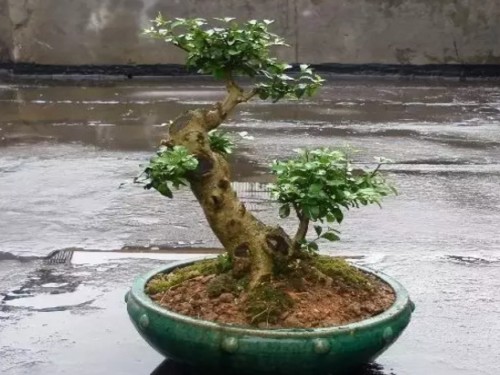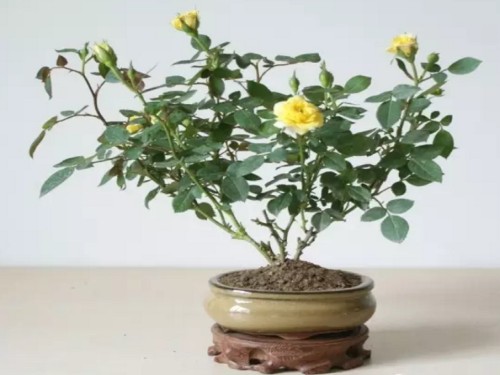Daily pruning skills of bonsai
The daily sporadic pruning of bonsai refers to the timely pruning in daily maintenance. Bonsai stumps cultivated from shrubs, their habits into clusters, bonsai modeling can be cultivated into "small trees" to improve its ornamental effect, so that it is originally a small shrub, but appears in the basin into a "towering tree" shape. For the material, except for the theme of landscaping and the twigs (buds) that are prepared to make up for the deficiencies, the rest should be managed and cut off, and the shape of directional cultivation should be strictly controlled, otherwise it is easy to grow at random and violate the purpose of modeling.
Although many trees are pruned twice in winter and spring, because there are many hidden buds, new branches will sprout from time to time in the roots, stems and branches, affecting the nutrient distribution and ornamental effect, such as Chinese wolfberry, triangular maple, sparrow plum, elm and so on. Therefore, once it is found in daily management, it should be removed in time to keep the body clean and complete, so as to facilitate ventilation and light transmission, which is more conducive to viewing.

Proper pruning and timely pruning can improve the resistance of bonsai. In daily pruning, attention should be paid to the cleaning of diseased branches, diseased leaves, dead branches, old, weak and stiff branches, and the cut branches should be removed thoroughly to avoid cross-infection. however, the withered branches and residual branches consciously left in order to compose the content will not be pruned. There are also many bonsai stumps that gain parental advantages through grafting, such as red maple and golden beans. Buds and branches from rootstocks should be peeled off in time in daily maintenance and management, otherwise they will compete for nutrition in the upper scion and affect the ornamental effect.
Through seasonal pruning, for twigs that have been formed and extracted into pieces, or those that have been deliberately cultivated and cultivated, they should not be cut to the required length until they have a high degree of Lignification in a certain stage, so that part of the nutrition can be accumulated in the process of growth. on the other hand, the branchlets are also sturdy and strong, which is consistent with the overall style, so we should not mistakenly think that only long branches must be cut. Otherwise, the trees will be trimmed into the shape of a "duster". For example, if the street trees are not pruned properly, they should be allowed to grow thick and long, and then make appropriate truncation, and in the future, they will sprout branchlets at this cut, and then let them grow long, thick and then cut short, so that they will be gradually formed and stored into branches over and over again, and the old stakes will form 6-7 grade branches, which are dense and beautiful.
For pruning and pruning, it is best to have a special person in charge of daily pruning: first, to understand the training intention of the original author; second, to avoid blind pruning. If these branches and buds are cut off for intentional branches or desired buds due to lack of understanding or different opinions of the pruners, it will cause irreparable mistakes. With special personnel in charge, such mistakes should be reduced and avoided.
In addition to being clear-sighted and quick, experienced pruners also make a correct distinction between the branches that have been pruned and preserved by their predecessors, the former has been cut off at the end, indicating that it is necessary to retain and cultivate the branches, while the latter is a complete branch with a well-preserved tip, indicating that it can be intercepted as needed, and mistakes can be avoided as long as it is careful.
The buds planted on the branches are called lateral buds, and their birth directions are generally above and on both sides of the branches, while the lower parts are less and are not easy to get sunlight after growing, so the direction of the buds should be taken into account when pruning, which should not only cause the bending changes of the natural growth of the branches, but also meet the needs of the overall shape, without repetition, cover, and do not interfere with each other, forming a ventilated, transparent, dense and moderate shape.
What we are talking about here today is the timely pruning of bonsai trees in our daily life. If the bonsai stump is a shrub, its growth habit is clumpy. When we design and shape it, we cultivate it into a "small tree". It is originally a small shrub, but it can also grow into a "towering tree" in the basin. Through this, we can improve the viewing effect of bonsai.
Except for the landscaping theme and the twigs that are ready to make up for the deficiency, the rest of the material must be managed and cut off, and only by strict control can the trees not scurry and grow at random.
Although bonsai trees are pruned twice in winter and spring, there are many hidden buds, sprouting new branches in roots, stems, branches and other places from time to time. In daily management, once found, they should be removed in time to ensure that the shape is clean and intact to facilitate ventilation and light transmission.
In normal pruning, pay attention to the cleaning of diseased branches, diseased leaves, dead branches, old, weak and stiff branches, and the cut branches should be removed thoroughly to avoid cross-infection. What needs to be mentioned here is that in order to compose the content, we should consciously leave dead branches and residual branches.
The twigs that have been formed and drawn into pieces should be cultivated consciously and grow to a high degree of Lignification at a stage and then cut to the required length. In this way, the branches can accumulate certain nutrients in the process of growth, and the twigs can also be more sturdy and powerful.
Time: 2019-06-10 Click:
- Prev

Modeling technology of bonsai of holly
Many studies have shown that holly is not only of medicinal value, but also an excellent landscaping tree species, its wild original species and cultivated varieties have strong cold tolerance, even if introduced to Shandong, it also shows good growth potential. Therefore, some scholars think that
- Next

How to prune the rose-- the pruning method of rose bonsai
Pruning is one of the important measures of rose management, pruning should be carried out at all stages of growth in order to ensure the blooming of the four seasons. During the growing period, sprouting, budding and removing residues should be carried out. Sprouting means to wipe out all the buds that grow too much in spring, except for 2 or 3 buds left on the main branch.
Related
- Fuxing push coffee new agricultural production and marketing class: lack of small-scale processing plants
- Jujube rice field leisure farm deep ploughing Yilan for five years to create a space for organic food and play
- Nongyu Farm-A trial of organic papaya for brave women with advanced technology
- Four points for attention in the prevention and control of diseases and insect pests of edible fungi
- How to add nutrient solution to Edible Fungi
- Is there any good way to control edible fungus mites?
- Open Inoculation Technology of Edible Fungi
- Is there any clever way to use fertilizer for edible fungus in winter?
- What agents are used to kill the pathogens of edible fungi in the mushroom shed?
- Rapid drying of Edible Fungi

